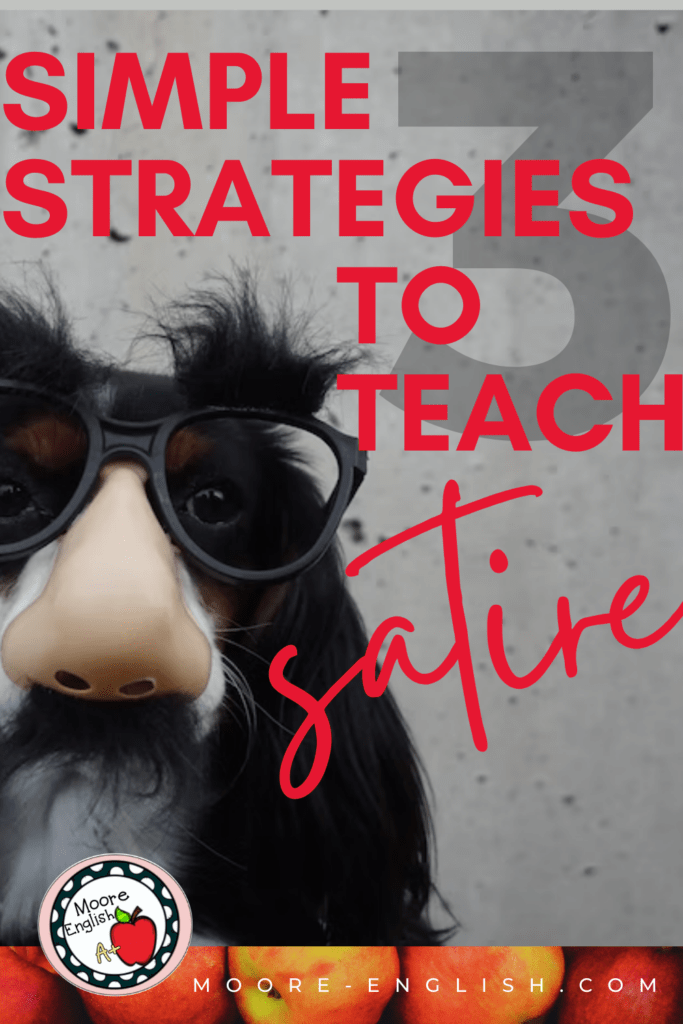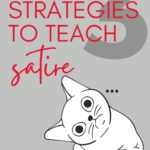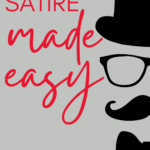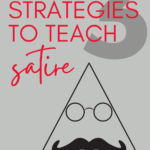“Satire” is a tough topic for the high school classroom. In my department, it’s a topic reserved mostly for junior and senior English classes. Overall, there’s so much to unpack in terms of tone, subject, and author’s purpose.
Today, I wanted to share three simple steps for helping students understand satire:
- inquiry-based learning
- visualization
- application
Teach Satire With Inquiry-Based Learning
Inquiry-based learning is one of my favorite ways to introduce a new concept. With this instructional model, students investigate to define. This is a strategy I use when introducing sonnets, aphorisms, and parallelism. To try inquiry-based learning with satirical texts, consider this lesson plan:
- First, divide students into groups and explain them that they are going to use examples of satire to determine its definition. If you’re interested in distinguishing between satire and parody, this would also be a good time to tell students.
- Then, provide students with a series of examples of satire. To keep students engaged, consider some clips from Saturday Night Live. This playlist of SNL advertisements is a perfect place to start. Obviously, you want to watch the clips to make sure they are school appropriate. Choose 4-8 clips that exemplify satire.
- As students watch the clips, they should list the characteristics that appear across videos. Then, students should use their list to develop a definition.
- Each group should share their definition, perhaps adding the definitions to a shared Google Slideshow or Jamboard. As a class, discuss the similarities between definitions and determine a class definition. As the teacher, you may need to make suggestions about how to refine or adjust the definition.
Visualizing Satire
Visualization is an important way of helping students make sense of new concepts and materials. Since satire is closely related to an author’s purpose, here are two great visualization tools to help students process the material.
- First, I long ago stopped using PIE to teach author’s purpose. I now use RECEIPT to teach author’s purpose (read all about this strategy). Since satire is so closely related to author’s purpose, this is the perfect place to use the RECEIPT acronym. This anchor chart is an ideal visualization tool.
- Similarly, SOAPSTone is a classic way to analyze author’s purpose, especially when you’re dealing with an argumentative text. SOAPSTone is a great complement to any lesson on satirical texts. For this reason, I’ve put together a SOAPSTone graphic organizer that you can grab today!
Choosing Satirical Texts
One of the most challenging parts of teaching satire is finding appropriate texts. On one hand, teachers want texts that are truly satirical but that also engage students. Finding texts that are written at the appropriate grade level and that suit the length of time you will be spending on satire is also a challenge.
To make this process a little easier, here are some great choices:
- First, “The Unknown Citizen” by W.H. Auden is a classic choice. In terms of teaching satire, this poem is a good length and clearly uses satire to criticize. The dystopian nature of the poem is always appealing to students. Read it here.
- Similarly, “We Are Not Responsible” by Harryette Mullen is a more contemporary take on satire. Written like a terms and conditions documents, this poem hits close to home. This is a perfect tool to help students understand the way satirical writing can be used in the modern world. Read it here.
- For longer texts, Northanger Abbey by Jane Austen is my favorite longform satire. Her send up of Gothic literature and Gothic heroines is the basis for one of my favorite lessons. Likewise, The Adventures of Huckleberry Finn by Mark Twain is a classic piece of satire. While this is a long novel, teachers can focus in on one or two episodes to study satirical writing.
What other texts do you use to teach satire?















